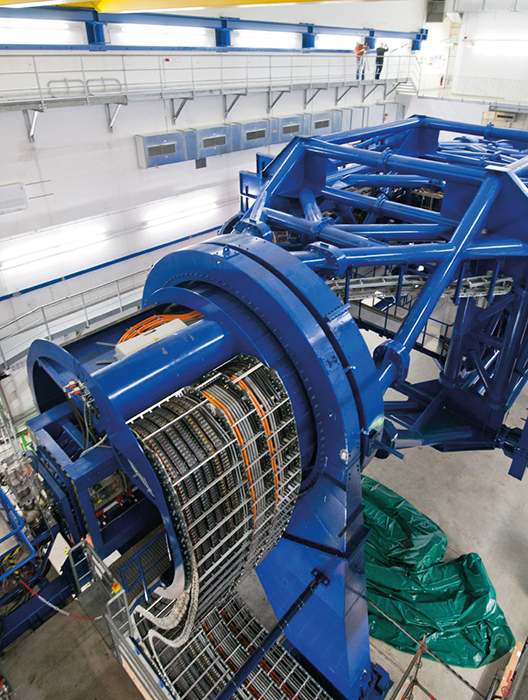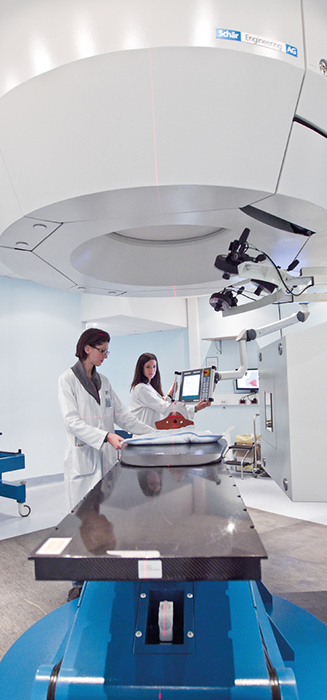The hadrontherapy community touches base.

Since the establishment of the first hospital-based proton-treatment centres in the 1990s, hadrontherapy has continued to progress in Europe and worldwide. In particular, during the last decade there has been exponential growth in the number of facilities, accompanied by a rapid increment in the number of patients treated, an expanded list of medical indications, and increasing interest in other types of ions, especially carbon. Harnessing the full potential of hadrontherapy requires the expertise and ability of physicists, physicians, radiobiologists, engineers, and information-technology experts, as well as collaboration between academic, research and industrial partners. Thirteen years ago, the necessity to catalyse efforts and co-operation among these disciplines led to the establishment of the European Network for Light Ion Hadrontherapy (ENLIGHT). Its recent annual meeting, held in Cracow in September, offered an ample overview of the current status and challenges of hadrontherapy, as well as stimulating discussion on the future organisation of the community.
Networking is key
ENLIGHT was launched in 2002 (CERN Courier May 2002 p29) with an ambitious, visionary and multifaceted plan to steer European research efforts in using ion beams for radiation therapy. ENLIGHT was envisaged not only as a common multidisciplinary platform, where participants could share knowledge and best practice, but also as a provider of training and education, and as an instrument to lobby for funding in critical research and innovation areas. During the years, the network has evolved, adapting its structure and goals to emerging scientific needs (CERN Courier June 2006 p27).
ICTR-PHE
The third edition of the International Conference on Translational Research in Radio-Oncology | Physics for Health in Europe will be held in Geneva from 15 to 19 February. This unique conference gathers scientists from a variety of fields, including detector physicists, radiochemists, nuclear-medicine physicians and other physicists, biologists, software developers, accelerator experts and oncologists.
ICTR-PHE is a biennial event, co-organised by CERN, where the main aim is to foster multidisciplinary research by positioning itself at the intersection of physics, medicine and biology. At ICTR-PHE, physicists, engineers and computer scientists share their knowledge and technologies, while doctors and biologists present their needs and vision for the medical tools of the future, therefore triggering breakthrough ideas and technological developments in specific areas.
The high standards set by the ICTR-PHE conferences have garnered not only an impressive scientific community, but also ever-increasing interest and participation from industry. ICTR-PHE 2016 is also an opportunity for companies to exhibit their products and services at the technical exhibition included in the programme.
The annual ENLIGHT meeting has always played a defining role in this evolutionary process. This year, new and long-time members were challenged to an open discussion on the future of the network, after a day and a half of inspiring talks on various aspects of hadrontherapy.
Challenges ahead
Emerging topics in all forms of radiation therapy are the collection, transfer and sharing of medical data, and the implementation of big data-analytics tools to inspect them. These tools will be crucial in implementing decision support systems, allowing treatment to be tailored to each individual patient. The flow of information in healthcare, and in particular in radiation therapy, is overwhelming not only in terms of data volume but also in terms of the diversity of data types involved. Indeed, experts need to analyse patient and tumour data, as well as complex physical dose arrays, and to correlate these with clinical outcomes that also have genetic determinants.

Image credit: ENLIGHT.
Hadrontherapy is facing a dilemma when it comes to designing clinical trials. In fact, from a clinical standpoint, the ever increasing number of hadrontherapy patients would allow randomised trials to be performed – that is, systematic clinical studies in which patients are treated with comparative methods to determine which is the most effective curative protocol.
However, several considerations add layers of complexity to the clinical-trials landscape: the need to compare standard photon radiotherapy not only with protons but also with carbon ions; the positive results of hadrontherapy treatments for main indications; and the non-negligible fact that most of the patients who contact a hadrontherapy centre are well informed about the technique, and will not accept being treated with conventional radiotherapy. Nevertheless, progress on clinical trials is being made. At the ENLIGHT meeting in Cracow, the two dual-ion (proton and carbon) centres in Europe – HIT, in Heidelberg (Germany) and CNAO, in Pavia (Italy) – presented patient numbers and dose-distribution studies carried out at their facilities. The data were collected mainly in cohort studies carried out within a single institution, and the results often highlighted the need for larger statistics and a unified database. More data from patients treated with carbon ions will soon become available, with the opening in 2016 of the MedAustron hadrontherapy centre in Wiener Neustadt (Austria). Clinical trials are also a major focus outside of Europe: in the US, several randomised and non-randomised trials have been set up to compare protons with photons, and to investigate either the survival improvement (for glioblastoma, non-small cell lung cancer, hepatocellular carcinoma, and oesophageal cancer) or the decrease of adverse effects (low-grade glioma, oropharyngeal cancer, nasopharyngeal cancer, prostate cancer and post-mastectomy radiotherapy in breast cancer). Recently, the National Cancer Institute in the US funded a trial comparing conventional radiation therapy and carbon ions for pancreatic cancer.

Image credit: HIT.
Besides clinical trials, personalised treatments are holding centre stage in the scientific debate on hadrontherapy. Technology is not dormant: developments are crucial to reduce the costs, to provide treatments tailored to each specific case, and to reach the necessary level of sophistication in beam delivery to treat complex cases such as tumours inside, or close to, moving organs. In this context, imaging is key. Today, it is becoming obvious that the optimal imaging tool will necessarily have to combine different imaging modalities, for example PET and prompt photons. PET is of course a mainstay for dose imaging, but a well-known issue in its application to in-beam real-time monitoring for hadrontherapy comes from having to allow room for the beam nozzle: partial-ring PET scanners cannot provide full angular sampling, therefore introducing artefacts in the reconstructed images. The time-of-flight (TOF) technique is often used to improve the image-reconstruction process. An innovative concept, called a J-PET scanner, detects back-to-back photons in plastic scintillators, and applies compressive sensing theory to obtain a better signal normalisation, and therefore improve the TOF resolution.

Image credit: MedAustron.
A subject of broad and current interest within the hadrontherapy community is radiobiology. There has been great progress in the comprehension of molecular tumour response to irradiation with both ions and photons, and of the biological consequences of the complex, less repairable DNA damage caused specifically by ions. Understanding the cell signalling mechanisms affected by hadrontherapy will lead to improvements in therapeutic efficacy. A particularly thorny issue is the relative biological effectiveness (RBE) of protons and carbon with respect to photons. More extensive and systematic radiobiology studies with different ions, under standardised dosimetry and laboratory conditions, are needed to clarify this and other open issues: these could be carried out at existing and future beamlines at HIT, CNAO and MedAustron, as well as at the proposed CERN OpenMED facility.
The future of ENLIGHT
Since the annual meeting in Summer 2014, the ENLIGHT community has started to discuss the future of the network, both in terms of structure and scientific priorities. It is clear that the focus of R&D for hadrontherapy has shifted since the birth of ENLIGHT, if only for the simple reason that the number of clinical centres (in particular for protons) has dramatically increased. Also, while technology developments are still needed to ensure optimal and more cost-effective treatment, proton therapy is now solidly in the hands of industry. The advent of single-room facilities will bring proton therapy, albeit with some restrictions, to smaller hospitals and clinical centres.

Image credit: CNAO.
From a clinical standpoint, the major challenge for ENLIGHT in the coming years will be to catalyse collaborative efforts in defining a road map for randomised trials and in studying the issue of RBE in detail. Concerning technology developments, efforts will continue on quality assurance through imaging and on the design of compact accelerators and gantries for ions heavier than protons. Information technologies will take centre stage, because data sharing, data analytics, and decision support systems will be key topics.
Training will be a major focus in the coming years, as the growing number of facilities require more and more trained personnel: the aim will be to train professionals who are highly skilled in their speciality but at the same time are familiar with the multidisciplinary aspects of hadrontherapy.
Over the years, the ENLIGHT community has shown a remarkable ability to reinvent itself, while maintaining its cornerstones of multidisciplinarity, integration, openness, and attention to future generations. The new list of priorities will allow the network to tackle the latest challenges of a frontier discipline such as hadrontherapy in the most effective way.







